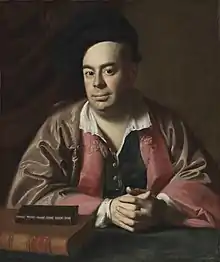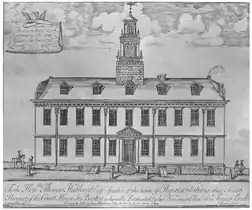Nathaniel Hurd
Nathaniel Hurd (c. 1729 – 1777) was an engraver and silversmith in Boston, Massachusetts, in the 18th century.[1] He engraved "bookplates ... heraldic devices, seals, ... paper currency, and business cards."[2][3]

Nathaniel Hurd | |
|---|---|
 Portrait of Nathaniel Hurd by John Singleton Copley, ca.1765 (Cleveland Museum of Art) | |
| Born | c. 1729 |
| Died | 1777 |
| Occupation | engraver and silversmith |
The lion rampant logo for the prestigious Phillips Exeter Academy is taken from a bookplate Hurd designed for John Phillips in 1775.[4] Examples of Hurd's work are in the collections of Harvard University; Yale University; Historic Deerfield;[5] the Lexington Historical Society; and the Museum of Fine Arts, Boston.

Nathaniel Hurd was the son of Jacob Hurd, a leading Boston silversmith, whose works are in the collections of the Peabody Essex Museum, Cleveland Museum of Art, Strawbery Banke Museum, and the Museum of Fine Arts, Boston.
References
- Charles Dexter Allen (1895), American book-plates, a guide to their study, London: George Bell & Sons, OCLC 1472039, OL 7058457M
- "Portrait of Nathaniel Hurd by Copley." Bulletin of the Cleveland Museum of Art, Vol. 10, No. 3 (Mar., 1923)
- American Broadsides and Ephemera, Series 1
- "The Exeter Lion Rampant". The Academy Archives. Trustees of Phillips Exeter Academy. Retrieved 11 January 2014.
- "Five Colleges and Historic Deerfield Museum Consortium".
- Cummings, Abbott Lowell. "A Recently Discovered Engraving of the Old State House in Boston," Colonial Society of Massachusetts, 2017. (https://www.colonialsociety.org/node/774) Retrieved August 2018.
Further reading
External links
| Wikimedia Commons has media related to Nathaniel Hurd. |